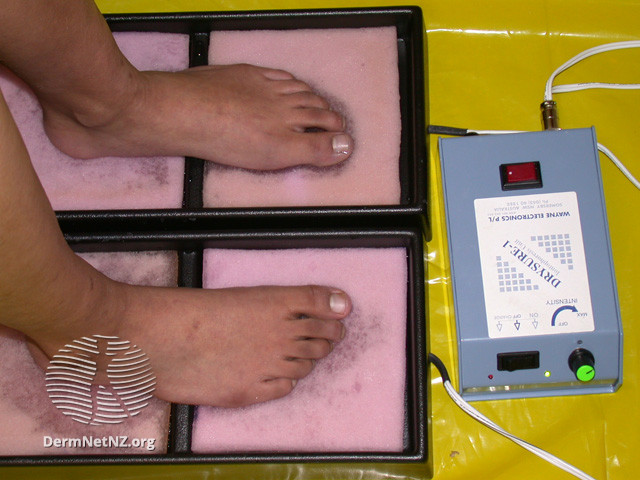Plantar fasciitis, a prevalent cause of foot and heel pain, poses a significant challenge. While traditional modalities such as ice, stretching exercises, strengthening routines, and heel cups have been the standard of treatment, a recent study has shed light on the remarkable efficacy of iontophoresis in providing immediate relief for patients.
Iontophoresis can play an important role in alleviating plantar fasciitis pain. Physicians should consider integrating this innovative approach into their initial treatment plans. Patients may also benefit from the use of Dexonto, a specialized medication designed to be used for iontophoresis.
Understanding Plantar Fasciitis: A Persistent Discomfort
Plantar fasciitis is characterized by inflammation of the plantar fascia, the thick band of tissue that connects the heel bone to the toes. The condition often manifests as stabbing pain near the heel, particularly with the first steps in the morning or after prolonged periods of rest. Common among athletes, individuals with flat feet, or those who stand for extended periods, plantar fasciitis can significantly impact quality of life.
Traditional Modalities: A Foundation for Resolution
Traditional treatments for plantar fasciitis have centered around a combination of ice application, stretching and strengthening exercises, and the use of heel cups. These approaches aim to address the underlying causes of plantar fasciitis, such as overuse, improper footwear, or biomechanical issues. While effective in working toward symptom resolution, these methods may require time and significant compliance from the patient for noticeable relief.
Iontophoresis: Immediate Relief for Plantar Fasciitis
A recent study comparing traditional modalities with iontophoresis has introduced a new methodology to plantar fasciitis treatment. Patients who underwent iontophoresis reported greater immediate relief of symptoms compared to those treated with traditional methods. This highlights the potential of iontophoresis as a valuable addition to the initial treatment approach, especially when rapid relief is a primary concern.
How Iontophoresis Works for Plantar Fasciitis:
Iontophoresis utilizes the principles of electromagnetism to deliver medications directly to the affected area, in this case, the inflamed plantar fascia. The three key components—medication, electrodes, and electrical current—work synergistically to provide targeted relief.
Medication:
Dexonto, a specialized medication formulated for iontophoresis, contains dexamethasone, a potent anti-inflammatory steroid. This medication is designed to be ionized, carrying a charge that allows it to be propelled through the skin and into the inflamed plantar fascia.
Electrodes:
Electrodes are strategically placed to create an electric field. The repelling electrode, carrying the same charge as the ionized medication, is placed near the heel, while the attracting electrode is positioned elsewhere on the body. This setup ensures the precise delivery of the medication to the affected area.
Electrical Current:
The application of a low-level electrical current activates the iontophoresis device, creating the necessary electric field. This field propels the charged medication ions through the skin, bypassing the natural barrier and reaching the inflamed plantar fascia. The result is a targeted and efficient delivery of the anti-inflammatory medication.
Why Physicians Should Consider Iontophoresis with Dexonto
Immediate Relief
The study’s findings underscore the immediate relief provided by iontophoresis. For patients seeking prompt alleviation of pain associated with plantar fasciitis, iontophoresis with Dexonto can be a valuable initial treatment option.
Precision in Drug Delivery
Iontophoresis ensures precise drug delivery to the site of inflammation, minimizing the risk of systemic side effects. Dexonto, with its specialized formulation, complements the targeted nature of iontophoresis, optimizing the therapeutic impact.
Enhanced Patient Compliance
Immediate relief can contribute to enhanced patient compliance with the treatment plan. Patients experiencing rapid improvements in pain are more likely to adhere to the prescribed regimen and actively participate in their recovery.
Non-Invasive Approach
Iontophoresis offers a non-invasive alternative to injections or surgical interventions. Patients appreciate the comfort associated with this approach, further promoting compliance, and reducing anxiety related to more invasive procedures.
Versatility of Applications
Beyond plantar fasciitis, iontophoresis with Dexonto has the potential for a wide range of applications in pain management. Physicians can leverage this versatility to address various localized conditions and enhance their treatment options.
Integrating Iontophoresis into Patient Care
Physicians looking to integrate iontophoresis into their initial treatment plans for plantar fasciitis can follow these key steps:
Patient Assessment
Conduct a comprehensive assessment of the patient’s condition, considering the severity of their plantar fasciitis, contributing factors, and the individual’s overall health.
Immediate Relief Needs
Identify patients who require immediate relief from pain as a primary treatment goal. This may include athletes, individuals with demanding lifestyles, or those seeking a faster resolution of symptoms.
Collaboration with Physical Therapists
Collaborate with physical therapists to create a comprehensive treatment plan that may include iontophoresis sessions alongside targeted exercises to address the underlying causes of plantar fasciitis.
Patient Education
Educate patients about the benefits of iontophoresis with Dexonto, emphasizing the potential for immediate relief and the non-invasive nature of the treatment. Address any concerns or questions they may have.
Regular Monitoring and Adjustments
Monitor patient progress regularly, adjusting the treatment plan as needed based on their response. This proactive approach ensures optimal outcomes and patient satisfaction.
Elevating Plantar Fasciitis Treatment with Iontophoresis
Plantar fasciitis pain can be a persistent challenge, impacting the daily lives of individuals and athletes alike. The study highlighting the immediate relief provided by iontophoresis, particularly when coupled with Dexonto, marks a significant advancement in the approach to plantar fasciitis treatment.
Physicians and physical therapists can now make iontophoresis an integral part of the initial treatment plan, offering patients a non-invasive, targeted, and efficient solution for the immediate relief of symptoms. By integrating iontophoresis with Dexonto into their arsenal of treatment options, physicians can elevate the standard of care for plantar fasciitis and provide patients with a swifter path to pain relief and overall improved quality of life.

